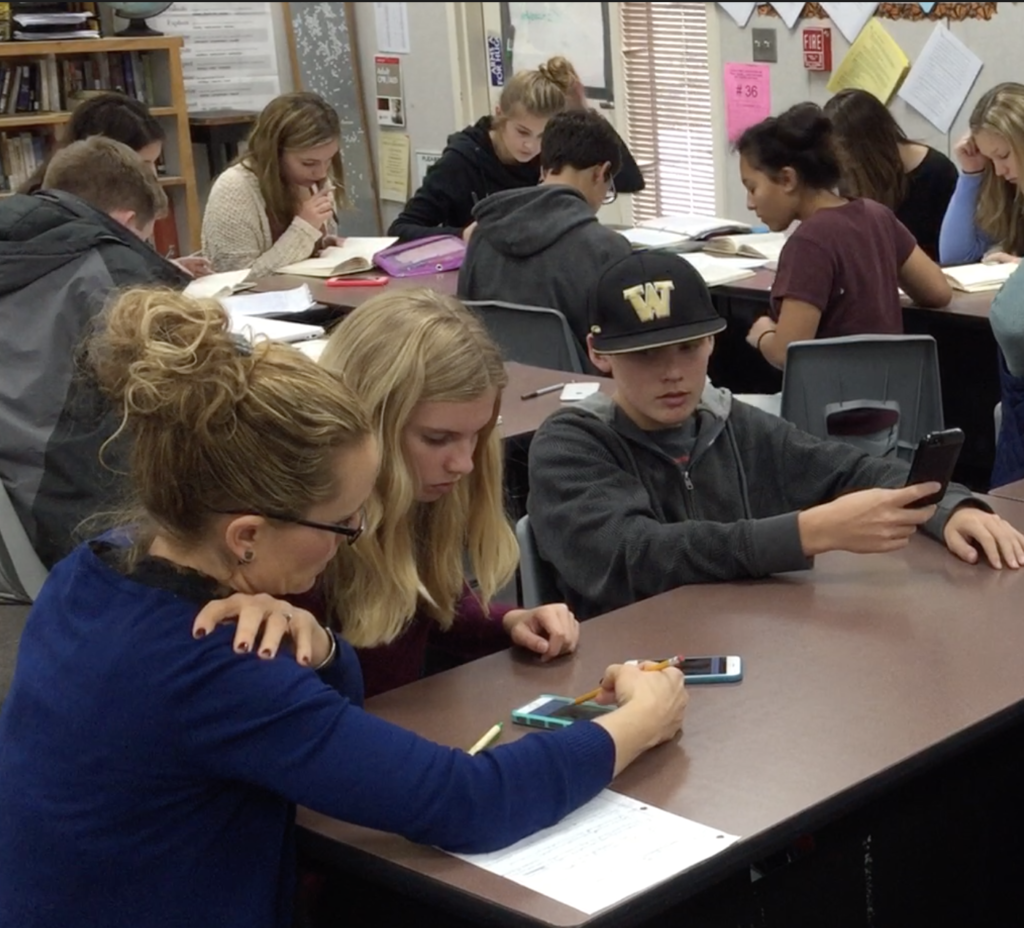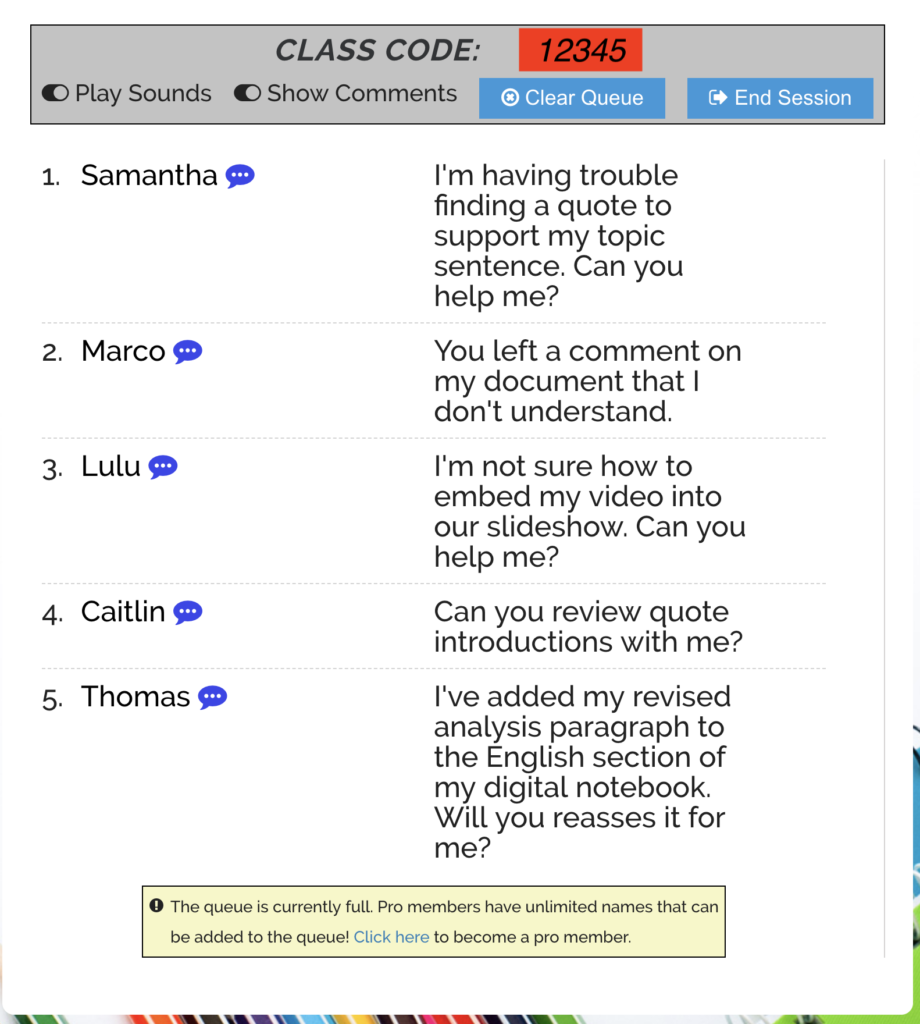Blended learning models afford teachers the time and space in class to work side-by-side with students. As a teacher works with a single student or a small group, other students will inevitably hit bumps and have questions that require the teacher’s attention. To avoid interruptions and distractions, teachers need a quick and easy way for students to ask for help or additional support.

ClassroomQ.com has designed a simple solution to solve this problem for teachers. Teachers create an account (free version available). They can start a “session” anytime they plan to lead small group instruction, conference with individual students, or move around the room during a self-paced lesson. Students can access the session with a class code and enter their names and comments to the queue.

Once the student has entered her name, written a brief comment, and pressed the “Assistance needed” button, the teacher will receive an alert and the student’s name will appear in the queue. The student can also see what number they are in line, so they can decide whether to wait for help or move onto something else until the teacher gets to them.

The free version allows up to five students to join the queue at any one time. Once a teacher has finished helping a student, he can simply click on their name and they are removed from the queue.

For those of us using blended learning models, this simple tool makes fielding questions and identifying students who need support more manageable.


11 Responses
[…] ClassroomQ: Streamline Questions & Provide Personalized Support | […]
Hi Catlin!
I LOVE this tool! And I also have another (unrelated) question I’m grappling with. How do you balance the full-text study with your pacing guide in the StudySync curriculum? The pacing guide touches on the full text every couple days, but doesn’t seem to dig any deeper than a brief discussion in class. Do you have any suggestions for the marrying of the two?
Thanks!
Hi Aly,
My English department is still novel based, but I use StudySync to drill into texts and skills. If we are focusing on identifying a theme or central idea in a text and how it progresses over time, we use a StudySync short story or excerpt. We rip those mini texts apart practicing then apply those skills to the novels we are reading. I definitely do NOT feel pressure to teach everything in a StudySync unit. Instead, I pick and choose the texts and lessons that complement our novels and target skills my students need (or assign different skills to different students at different levels).
I love all of the built-in scaffolds in StudySync. I have students in 9th grade who are reading at a 3 and 4th-grade level. I’m not sure what I would do without StudySync texts paired with audio readings and the scaffolds, because some of my students cannot access the novels designated for our class.
I hope that helps!
Catlin
I am playing around with the thought of Personalized Learning being the eventual goal of Blended Learning.
Hi Catlin! I learned about you way back when StudySync first came out and the public high school I worked at bought it along with chrome books for every student. You were (and still are) amazing at implementation and modeling of what works in a classroom setting, which helped me immensely but also intimidated me. I am now at a small private school with no one-to-one technology any longer and I am being challenged to step out and try new things with my students that will engage them, however, I feel like I am good at that part, just not so good at sometimes doing the things that will benefit them the most in the end. Activities come and go but the things that really stick and are meaningful are what I am after. With that said, I am trying your blogging idea in the classroom – it is 23 students who are a blended 11th and 12th grade doing British Literature. I am trying to get them to talk about theme (under cover of course) and I have simply set up a blog with several questions that they must answer. Is there more to it? I got the library so those that didn’t have phones could log in and respond…I don’t know if this is worthy of time or not in the ELA classroom. I often second guess myself too!! I also wondered if there are any other resources you could point me to as we are a very poor private school and I am constantly having to buy things off of TPT to supplement literature books from 2008. I do miss StudySync!! We do whole novels here, which I love, BUT I’d like to have more resources to help them write as we go through the novel, not just when we get to a critical analysis essay. Lot’s of questions and hoping you may point me in the right direction!! 🙂
Hi Steffany,
I obviously love blogging, so I absolutely believe it has a place in the ELA classroom. I took a more hands-off approach to my students’ blogs. I was inspired by Google’s 20% time and decided to take that concept and combine it with blogging. My students decided on the topic of their blogs, then I presented them with challenges (write a “how to” blog, write a review, include original media, etc.) to help them practice writing for different audiences and purposes. I also wanted them to develop technology skills that would be useful beyond our classroom. You can read more about my passion blogs HERE.
I’m so sad you lost access to StudySync when you moved schools. Have you ever checked out Common Lit? Not nearly as comprehensive as StudySync, but it is an awesome free option for a range of texts (short stories, speeches, news articles). I would also recommend checking out Smithsonian Tween Tribune if you are looking for articles (a free alternative to Newsela) written at different Lexile levels.
Good luck!
Catlin
Catlin,
This is an awesome blog! Your research and work is stunning and detailed for useful resources. I have never tried StudySync or ClassroomQ but I think ClassroomQ will be beneficial to my students at some point this year. My students been writing so much in their personal books that I didn’t realize its considered blogging/journaling. Sometimes they freestyle and create their own choices and sometimes they are given topics or themes to focus on for the weekly writing. I need to work on trying to help them do an activity on their iPads probably! What do you guys think? Can this be used for a group of writing kindergarteners? Just curious to know how we could benefit from this at this age. Thanks
Hi Catlin,
I’m Kyle Niemis, one of the teachers who made ClassroomQ. Just wanted to say thanks so much for the write up. I love your stuff and we are honored to have made it on your blog!
Hi Kyle,
Thanks for the note. It was my pleasure to feature ClassroomQ. Its functionality is ideal for teachers using blended learning models that prioritize work with small groups or individual students.
Catlin
I’m glad you mentioned this Catlin! I have small group that I work with during our Skills Block and I would love to try and see how ClassroomQ would be useful with a group of 2-4 five year olds? Thanks
Es más factible tener control de los temas módulo general así como objetivo específico así tengo una respuesta rápida para mis estudiantes